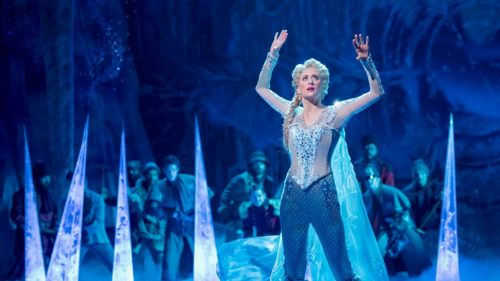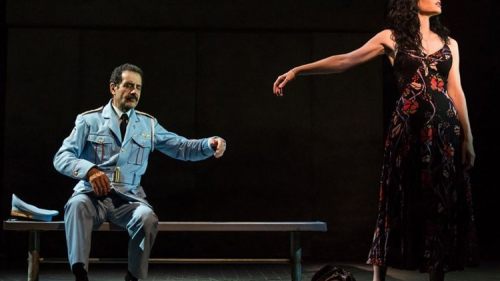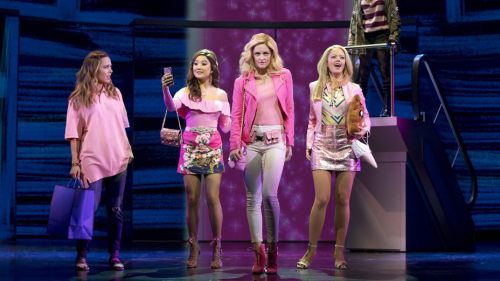ANASTASIA: A Cinematic Broadway Musical
Photo credit: Joan Marcus
It’s been two decades since 20th Century Fox released Anastasia, the landmark animated musical about Grand Duchess Anastasia Nikolaevna. More legend and whisper than historical fact, the story was ripe for a fantasy telling filled with magic and mystical creatures, a “Disneyfication,” if you will, resulting in one of ‘90s American animation’s artistic high-points. Its staged adaptation however, which began its Broadways run this past April, takes a markedly different approach to the material, with one foot planted firmly in history. Not in historical fact, mind you – the Grand Duchess still survives the October Revolution, she still loses her memory, and this is still her story – but rather, its focus is on the nature of historicity itself; the nexus between the past in all its pomp and tradition, and the future in all its possibility.
Gone are the Americanized Russian accents of the animated feature, replaced instead by theatrical cadence enunciated for the folks in Row Z. Anastasia: The New Musical is a distinct product of the theatre, a show where every movement and emotion is exaggerated for maximum impact. Whether the quick, coordinated shuffles of actors as they’re stopped from escaping their destiny, or the lavish chorus that moves between them like invisible ghosts, the show has “Broadway” written all over it but it also leans heavily on cinema. A single set of pillared arches forms most of the settings, with matte projections painting the background of a given scene. The space is either filled by more walls, or by fire, or even by Paris off in the distance, growing closer as the characters sing their way towards it. Like its chosen dynamic between past and future, it feel distinctly like the confluence of an age-old art form and the new media slowly replacing it.
Thematically, the idea of replacement – and the fear of being replaced – finds itself the focus of the story once more. The grand opening number “Dance of the Romanovs” (following the familiar “Once Upon A December,” which appears in the form of prologue) is followed swiftly by the Bolshevik revolution. The “evil sorcerer” version of Rasputin is replaced in the musical by the people and the military, making the revolution an organic outcome of Tsarist aristocracy, as opposed to magical influence. As St. Petersburg becomes Leningrad, a new antagonist emerges in the form of Gleb Vaganov (the charming Ramin Karimloo), a second generation military general tasked with finding and killing the rumoured sole survivor of the Imperial family.
The Duchess has survived, though she has no memory of her past life. She works as a street sweeper amidst the lively people of Leningrad who attempt to pass off paintings and other memorabilia as authentic royal heirlooms. Like in the film, the scheme hatched by Dimitry and former nobleman Vlad remains unchanged – train a young girl to impersonate Anastasia and collect her grandmother’s reward – though the secondary characters undergo some necessary expansions for the show’s inflated runtime. Vladimir Vasilovich is now Vlad Popov, and his relationship with Sophie Stanislavovna Somorkov-Smirnoff (renamed Lily Malevsky-Malevitch) takes center stage for a good portion of the second Act, as the duo of John Bolton and Caroline O’Conner attempt to re-capture the characters’ spark amidst numbers like “Land of Yesterday,” an upbeat swing piece rooted in nostalgia.
Derek Klena’s Dimitry is a charming presence, but it’s Christy Altomare that elevates the entire production. Her Anastasia is small in stature, hiding from the world in an ill-fitting overcoat until it’s time to let loose and belt out the show-stopping Act I capper “Journey to the Past.” The two lead performers fit American animation’s prince and princess archetypes so perfectly it’s as if they were brought to life from some animated classic
“In a Crowd of Thousands” tells the new backstory of Anastasia and Dimitry’s first meeting, in passing rather than as a product of the revolution. While the show is more “grounded” than its animated predecessor, foregoing any and all supernatural elements, this one change and its accompanying duet help add a singular fantastical spark, making the story of Anya and Dimitry as much a tale of destiny as one of realistic growth and change. As children, they crossed one another like ships in the night – or like the changing or empires.
As the pillars holding up Russia are struck down and replaced, so too is the country’s consciousness. Gleb, the conflicted general, provides much-needed antagonistic nuance in the form of a man caught between duty – to his father, to his superiors, and to his country – and his impulse to be a good man, wholly distinct from any entity he answers to. It’s this addition of Gleb that allows the story’s themes to be yanked to the surface in the third act, as he embodies the other side to Anastasia’s coin. Where she represents the old Russia, an aristocratic way of life that cannot thrive in the modern world (a way of life her grandmother and Lily hold on to regardless, since it’s all they’ve ever known), Gleb embodies the need to move forward, unburdened by the constraints of the past, even to the point of self-detriment. In effect, the show places both the aristocracy and Leninist Russia in its rear view, the sort of extremes doomed to replace one another unless characters like Dimitry, Gleb and Anastasia stand up and claim their autonomy within these overwhelming systems.
In Anastasia: The New Musical, the specters of the past loom large both as corporeal ghosts and the weight of dutiful guilt. They are made ethereal in the form of song and ushered gently into the past, as even alternate history is re-written – in the form of an ode to all things yet to come once we’re done holding on. It isn’t easy to let go of the world that once was, just as radical changes to this story may not sit well with those who have spent decades taking comfort in it. But the narratives around us will continue to grow, and we’re capable of growing with them.



